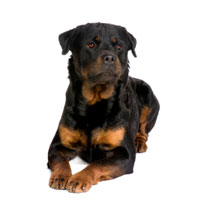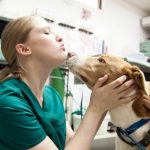Canine hip dysplasia occurs because a dog has an abnormal hip joint.
In This Article You Will Read About
One where the ‘ball-and-socket’ structure is loose, rather than the correct ‘snug’ fit.

There are 3 possible defects which can cause a loose hip joint…
- The hip socket is too shallow
- The ball is too small or isn’t rounded enough
- The ligaments that hold the joint in place are too loose
Any of these problems can cause the hip joint to move around too much, to slip or even to ‘pop out’ of place.
This can cause the hips to make a clicking sound, the dog to have a limp or wobbly/bouncy walk, difficulty getting up, and of course pain.
Years of this sort of incorrect movement and ‘wear and tear’ often leads to the dog developing arthritis in the affected hip/s.
There is also a condition called Elbow Dysplasia, which produces similar symptoms, but in the front legs rather than the rear ones.
CLICK HERE to learn more about the
Symptoms & Treatment of Canine Hip Dysplasia
Causes Of Hip Dysplasia In Dogs
Here are the three most common causes of canine hip dysplasia:
Hereditary or Genetic Factors
Although there are two other things that can also lead to hip dyspslasia in dogs, some experts believe that a pup has to already have a genetic predisposition to the disease in order for this to happen.
Statistics relating to hip dysplasia in specific breeds, such as Rottweilers, doesn’t necessarily give us a clear picture of what’s happening.
Studies have been undertaken by different organizations and in different countries. The results are varied, and sometimes conflicting.
Recent figures from the Orthopedic Foundation for Animals (OFA) indicate that just over 20% of Rotties evaluated for OFA certification have ‘abnormal’ hips.
It’s likely that the overall figures for hip dysplasia in dogs are considerably higher though, as the majority of dogs aren’t evaluated.
The good news is that due to breeders’ increasing awareness of the genetic component in canine hip dysplasia, the situation is improving.
This genetic factor isn’t clear-cut and is, in fact, pretty complex.
The specific gene involved can be ‘carried’ by a dog without him/her showing any symptoms.
If this dog is then bred to another dog who doesn’t have the disease (and isn’t a ‘carrier’), the puppies are still at a greater risk of developing canine hip dysplasia than pups whose parents are both free of this gene.
If two dysplastic dogs are bred to each other (even if one is a ‘carrier’), the resulting puppies have a much greater risk of developing symptoms or being a-symptomatic ‘carriers’ and will continue to pass this on to their offspring.
All of this makes it no easy job to eliminate the gene for hip dysplasia in dogs from any one breeding program, or even a particular bloodline.
Reputable and responsible breeders are making huge efforts to only breed dogs who do not have, or carry, the gene for this condition and it is helping… but there’s still a long way to go.
How Diet Can Affect Hip Dysplasia In Dogs
Large breed puppies tend to grow very quickly, and sometimes erratically, and a diet that isn’t designed to meet the very individual needs of these puppies can cause growth spurts that put excessive stress on their joint and ligaments.
In puppies who are predisposed to developing canine hip dysplasia (perhaps due to the genetic component) this can trigger the onset of the disease.
The main problem is usually either that the pup is being fed too much food, or one that doesn’t have the correct balance of nutrients.
When you’re Feeding Rottweiler (and other large breed) puppies the right diet is vital to their overall health and development.
Choose only a premium puppy food (see my Best Puppy Food page for more info. and examples) specifically formulated for large breed puppies, and one that falls within the preferred ratio of protein, fat and calcium.
Ideally look for…
- Protein: 23% – 25%
- Fat: 12% – 15%
- Calcium: 1.2% – 1.5%
Adding calcium or other minerals can do more harm than good and isn’t recommended unless for some specific reason your pups’ diet is lacking in the proper nutrients.
It’s also very important not to overfeed your Rottweiler pup in an attempt to make him/her grow bigger, or faster.
The eventual height/weight of your pup is determined by bloodlines and genetics more than anything else.
Although an excellent diet, proper veterinary care and adequate exercise will maximize his potential, overfeeding will only lead to excess weight gain and extra strain on his growing bones and ligaments.
It’s never a good idea to ‘free-feed’ a puppy, that is in terms of leaving their food bowl down and letting them eat as much and as often as they want.
This can lead to eating problems such as all-day snacking, which can result in an overweight dog.
It’s best to offer your pup the amount of food that’s appropriate for his age/breed/weight (guidelines are generally on the food bag as a starting point), twice a day.
No tidbits or inappropriate snacking between meals either – with the exception of small rewards during training sessions.
Exercise & It’s Role In Canine Hip Dysplasia
All puppies need exercise, and large breed pups can need quite a bit of space to work off that boundless ‘puppy energy’. BUT, too much of a good thing is never good!
Because they’re big and heavy, and often a bit clumsy or poorly co-ordinated due to erratic growth spurts, large breed pups can get injured or hurt more easily than you may expect.
Excessive amounts of exercise can also put too much strain on those growing bones, joints and ligaments. This can cause damage and in pups who have the predisposition to canine hip dysplasia it can trigger symptoms of the disease.
Daily walks, a romp in the back-yard or play sessions with the kids or other dogs are fine as long as you supervise and don’t allow them to become excessive.
But don’t let your large breed puppy do anything that involves jumping such as in/out of a truck, off walls or several steps etc. as this is a common cause of injury.
Also avoid long hikes, or much running on hard surfaces such as cement or asphalt. Save activities like these until your puppy is mature and his bones/joints are fully developed.
For Rottweilers this can take around 18 months to 2 years, or longer.
Preventing Canine Hip Dysplasia In Dogs
If your dog already has a genetic predisposition towards hip dysplasia there’s nothing you can do that will guarantee to prevent him from developing the condition. But, there are things you can do to minimize his risk.
If you haven’t already added your pup/dog to the family, taking a few simple steps can help prevent you from bringing home a dog who is likely to have issues with his hips.
Here’s a quick look at what YOU can do to help reduce the likelihood of problems…
Choose Your Puppy Carefully
Taking the time to find a responsible, reputable breeder is one of the most important parts of choosing a puppy.
Make sure that the parents of your puppy have had the appropriate health screenings that include OFA or PennHIP evaluations.
You can learn all about this on my Choosing A Rottweiler Breeder page.
Feed Your Puppy A Properly Balanced Diet
Pay close attention to your puppy’s diet, and only feed a premium puppy food that has been specifically formulated for large breed puppies.
Don’t overfeed or free-feed and don’t add unnecessary supplements like additional calcium.
There are some supplements that are designed to help encourage strong bones and joints. Glucosamine and Chondroitin are just two of these. Ask your vet for recommendations or suggestions.
Keep a growing puppy ‘lean’ to prevent extra stress on rapidly developing bones, joints and ligaments.
Your vet can tell you if your pup is at a healthy weight.Check out my Feeding Puppies and Best Puppy Food pages to learn more.
Monitor Exercise & Avoid Excesses
Don’t overdo the exercise!
Although large breed puppies look very sturdy, they’re actually quite fragile during their growth stages.
Daily walks and play sessions are important (and good for your pup/dog) but don’t take your pup hiking, jogging on hard surfaces or allow him to join in activities that require jumping.
Related Pages….
- Symptoms & Treatment of Canine Hip Dysplasia
- Canine Health Issues
- Caring For Big Dog Breeds
- Dog Diseases & Symptoms

